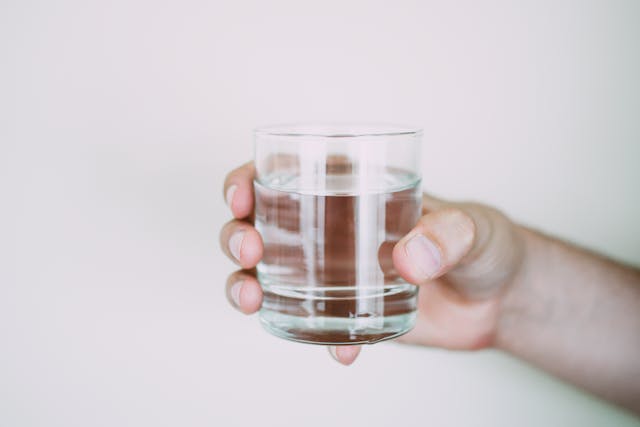- RO water removes all minerals, microplastics, and antibiotic residues
- However, it also removes trace elements of calcium, magnesium, sodium, potassium, chloride, sulfate, fluoride, chromium, copper, manganese, zinc, and iron
- This may have harmful health effects
What is RO Water?
Reverse osmosis is the process where water is deionised, demineralised, and all (or most) chemicals, bacteria, viruses, microplastics, and antibiotic residues are also removed. Water is pushed through a semi-permeable membrane (filter) making it clean and safe to drink.
This is a cross-filtration system, where the filtered water is not collected in the filter itself, but instead the contaminated water is removed from the system.
What Does an RO System Remove?
These systems generally remove about 99% of impurities, anything which has a molecular weight of more than 200. Water has a weight of 18 g/mol, and microplastics range from 0.001 micron upwards for reference.
An RO removes:
- Bacteria, pathogens, and viruses
- Anything with a high ionic charge, such as salts
- Organic material
- Electrolytes
- Antibiotics
- Colloids
- Nitrates
- Heavy metals
- Microplastics
- Minerals
While this water is now safe to drink, it creates two problems.
- One is that the resulting water can have a slightly lower pH level
- The other, and bigger problem, is that it strips all minerals from the water.
What is the Problem with RO Systems?
Because they remove 99% of impurities, this means everything, including calcium, zinc, iron, potassium, magnesium, sodium, and fluoride. These trace minerals, called ‘total dissolved solids’ (TDS) are beneficial, and our bodies need them to function properly.
TDS ppm (parts per million) should be between 300-600. In RO water, it’s usually under 25ppm. The lack of minerals makes the water ‘dead’. It tastes flat and some say almost metallic.
But this is not just about taste. Drinkers of RO water are missing out on all these beneficial minerals. While these are only trace levels of minerals, an alarming study showed that in order to make up for these missing minerals and electrolytes, the body leaches minerals from your bones and organs.
If you cook vegetables in this water, there is substantial loss of vitamins and minerals from the food.
Symptoms from this lack of trace minerals begin with tiredness, muscle cramps, weakness, and cardiovascular problems. Over time, compromised organs and bones can deteriorate. That means more broken bones in children, higher rates of cancer, cardiovascular problems and deaths, and a raft of other health issues.
WHO notes that while RO systems are excellent for desalination and removing harmful bacteria, they should not be used unless necessary. RO water is not optimal for good health.
The other big problem is that the system results in huge amounts of waste water, sometimes up to two to three cups of water for every one cup purified. Users should collect this waste water and use it to water plants, run the washing machine, or some other use that is not ingestion.
What About RO Systems That ‘Remineralise’ and Add Minerals Back In?
To counteract these harmful effects of RO water, many RO systems have installed remineralization components. These are designed to add magnesium, calcium and other minerals back into the water, making it beneficial to drink.
The filtered water enters a chamber where it is pushed through a range of minerals such as calcite and various ceramic balls.
However, there’s little to no regulation nor independent lab testing of what is added; how can you trust what’s being added is healthy or within the (disputed) guidelines? Here at Raising Indian Kids, we contacted AO Smith and PureIt and asked for information regarding:
- What minerals they were adding, and
- How much would be in the water
However, we never got a response.
Studies on remineralisation don’t shed much light on if it’s beneficial either. One study showed the water tasted a lot better after remineralisation, which is an encouraging sign.
The WHO says that it’s almost impossible recreate natural water with all trace elements and minerals. But for many in India, a plentiful supply of fresh, safe, water is almost impossible without an RO system. The alternative, unfiltered water, is a host of bacteria and water-borne diseases such as cholera, typhoid, giardia, and amoebic dysentery. These diseases can be inconvenient and painful at best, deadly at worst.
The problem begins with dissent across agencies about what should be in water, and the amounts of it. Below is a table pulled from the Journal of Indian Water Works, with suggested upper and lower limits pulled from a number of sources.
We paid Rs2500 to have water tested from an AO Smith RO system and the results are in the fourth column.
| Mineral | Maximum PPM suggested | Minimum PPM suggested | RO Water Testing Results from AO Smith Machine |
| TDS (Total dissolved solids) | 500 | 50 | 83 |
| Calcium Ca+2 | 400 | Not specified | 16 |
| Magnesium Mg+2 | 50 | Not specified | 5 |
| Sodium Na+ | 200 | Not specified | 2.91 |
| Potassium K+ | 12 | Not specified | Not measured |
| Chloride Cl- | 250 | Not specified | 39 |
| Sulfate SO | 500 | Not specified | None |
| Fluoride F- | 2.0 | Not specified | 1 |
| Chromium Cr+3 | 0.1 | Not specified | BDL |
| Copper Cu+2 | 3.0 | Not specified | BDL |
| Manganese Mn+2 | 0.1 | Not specified | BDL |
| Zinc Zn+2 | 5.0 | Not specified | BDL |
| Iron Fe+2 | 0.3 | Not specified | 0.10 |
While I can’t comment officially if those ‘remineralised’ TDS levels are too low, the overall TDS levels are on the lower end of the scale. If you, or someone you know, can make an official and educated response, please get them to contact us at namaste@raisingindiankids.com. We have approached a number of experts, none of whom are willing or able to comment.

What About UV Water Purifiers?
UV water purifiers use ultraviolet light to make it safe to drink. The UV rays eradicate viruses, bacteria and other pathogens. There’s no waste water. However, it doesn’t remove dissolved solids. This means if the water supply has high levels of metals, antibiotics, or minerals, they remain in the water (although some antibiotics may deteriorate under the UV). In Mumbai, where water from the tap is already treated, UV filters could be enough.
What About Boiling Water?
You’ll need to boil the water for at least one minute, then let it cool. While this kills viruses, bacteria, and other pathogens, it does nothing for excessive TDS or antibiotic residue or microplastics. It also is another task for the woman of the house to complete.
While this makes the water safe, it may not be ideal or optimal health.
What About Bottled Water?
Bottled water in India, while usually safe to drink, often is not strictly monitored in terms of TDS. Water has been found to have varying levels of fluoride, for instance, and these varying levels can be applied across all minerals.
Bottled water also has microplastics.
Is RO Water Safe for Babies and Toddlers to Drink?
Honestly, it’s hard to know. Yes, it’s safe to drink if the unit is maintained well, as all viruses, bacteria, pathogens, and other impurities are removed. But does the water have enough TDS? If there’s no remineralisation, the answer is no. If there is a remineralisation component, the answer is- maybe.
Do not cook with RO water, instead use water from the tap. It will be safe once cooked over 74o Celsius, and there’s no risk of demineralisation. It also saves your water filter and a bunch of wasted water.
The most important thing is the water should be safe, with nothing that will make your child ill. Whether the water is lacking in minerals, and if that causes harm, is hard to determine. After water testing my RO system, I purchased a TDS tester online, and remineralisation drops but I cannot advocate that for others without advice from a water scientist.

